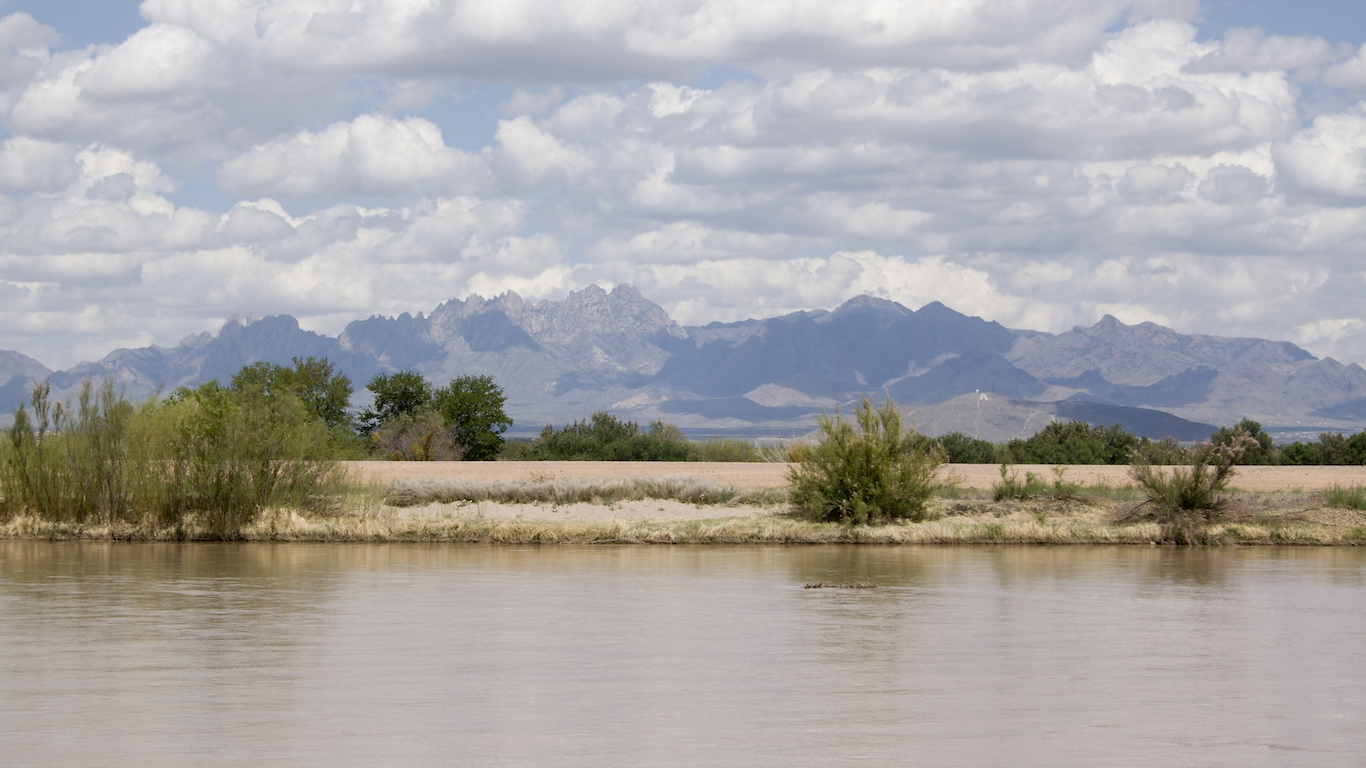Special Report
23 Counties With the Most Contaminated Water

Published:
Last Updated:

Since the Safe Drinking Water Act was passed in 1974, the U.S. Environmental Protection Agency has regulated a growing list of contaminants to protect public drinking water. The SDWA requires the more than 170,000 public water systems in the United States to regularly test their water supply against both naturally-occurring and manmade contaminants that may be found in drinking water.
Still, every year dozens of potentially harmful contaminants are found to be in excess of their EPA-set limits. In the last four decades, the EPA has issued more than 15,000 violations for the presence of dangerous levels of chemicals in municipal water supplies around the country.
To determine the counties with the most contaminated water, 24/7 Wall St. reviewed the number of water quality violations the EPA issued to each public water system in the United States and its territories from September 30, 1980 to July 3, 2017 using data from the EPA’s Safe Drinking Water Information System. There are 23 counties that were issued more than 50 water quality violations over that period.
Click here to see the 23 counties with the most contaminated water.
Click here to see our detailed findings and methodology.

23. Dona Ana County, New Mexico
> Water system: Las Cruces Municipal Water System
> Number of max. contaminant level violations since 1980: 52
> Population served by water system: 102,308
> Most recent violation: November 20, 2008
The Las Cruces Municipal Water System received all 52 of its water quality violations of the last four decades in the period between August 2005 and November 2008. Nearly all of the violations were due to levels of uranium in the water higher than the maximum allowed concentration. One source of the contaminant may be the NASA White Sands Test Facility, where uranium was historically used in missile tests. Uranium also occurs naturally in many parts of Dona Ana County.
[in-text-ad]

22. Grady County, Oklahoma
> Water system: Chickasha Municipal Authority
> Number of max. contaminant level violations since 1980: 52
> Population served by water system: 16,036
> Most recent violation: March 24, 2017
Over the past three years, the EPA issued 47 water quality violations to the Chickasha Municipal Authority water system in Grady County, Oklahoma. The violations were mostly due to excessive levels of TTHM — dibromochloromethane, bromoform, chloroform, and bromodichloromethane — in the water. As a result, Chickasha switched the disinfectant it uses for purifying the water supply from chlorine to chloramines, which are less likely to produce TTHMs. At high concentrations, TTHM can increase the risk of cancer and cause damage to the heart, lungs, kidney, liver, and central nervous system.

21. Rio Arriba County, New Mexico
> Water system: Espanola Water System
> Number of max. contaminant level violations since 1980: 52
> Population served by water system: 10,495
> Most recent violation: March 24, 2017
The EPA issued 40 violations to the Espanola Water System due to excessive levels of various radioactive elements between 2009 and 2011. In addition to several naturally occurring radioactive deposits that may have contaminated the water supply in Rio Arriba County, the area was the site of Project Gasbuggy, an underground nuclear detonation carried out by the U.S. Atomic Energy Commission in December 1967. While the Department of Energy (DOE) has stated that there has been no evidence of Gasbuggy-related contamination to date, the DOE has also claimed that there is no technology capable of remediating underground nuclear detonation sites, and will continue to monitor the site. In recent years, the Espanola Water System has also been issued violations for arsenic, which is also naturally occurring and can lead to an increased risk of cancer and skin disease with long-term exposure.

20. Custer County, Oklahoma
> Water system: Weatherford
> Number of max. contaminant level violations since 1980: 53
> Population served by water system: 10,833
> Most recent violation: August 27, 2012
Of the 53 contamination violations issued to the Weatherford water system, 43 were due to excessive levels of arsenic — a naturally occurring element found in rocks — over the past decade. Symptoms of short-term exposure to arsenic include vomiting, abdominal pain, and diarrhea, among others. Long-term exposure can result in conditions such as heart disease, skin disease, and cancer. While arsenic is a naturally occurring element, it is also possible that Oklahoma’s historical smelters may have contributed to the prevalence of arsenic in the soil and therefore the water system across the state. Public water systems in other counties in Oklahoma, such as Cleveland County and Canadian County, have been issued violations for excessive levels of arsenic in recent years. At this time, a regulatory cleanup level of arsenic has yet to be issued by the EPA or the Department of Environmental Quality in Oklahoma.
[in-text-ad-2]

19. San Juan, Puerto Rico
> Water system: Metropolitano
> Number of max. contaminant level violations since 1980: 55
> Population served by water system: 1,064,730
> Most recent violation: June 1, 2017
San Juan, Puerto Rico is one of the poorest county equivalents in the United States and its territories with 42.3% of the population living in poverty. The EPA cited the water system, Metropolitano, with 16 consecutive violations of excessive coliform from 2000 to 2011. Including coliform, the EPA has issued a total of 55 violations to the Metropolitano water system since 1987. The water system was issued 18 violations for total trihalomethanes and 13 violations for total haloacetic acids — byproducts of the water disinfection process. There are five haloacetic acids that can cause damage to the nervous system and liver if consumed in excess. Total trihalomethanes are similar to haloacetic acids, and can increase the risk of cancer and certain birth defects with long-term exposure.

18. Bergen County, New Jersey
> Water system: Ramsey Water Department
> Number of max. contaminant level violations since 1980: 56
> Population served by water system: 15,207
> Most recent violation: February 23, 2011
Ramsey Water Department in Bergen County, New Jersey has been slapped with a total of 56 water quality violations since 2002 — 45 of which were for excessive levels of arsenic. While arsenic is a naturally occurring element found in rocks that erode over time and enter the soil and water, consuming too much of it can put people at risk for diseases such as skin, lung, bladder, and kidney cancer.
[in-text-ad]

17. San Bernardino County, California
> Water system: US Army – Fort Irwin
> Number of max. contaminant level violations since 1980: 60
> Population served by water system: 16,000
> Most recent violation: August 17, 2016
San Bernardino County is home to Fort Irwin, a U.S. military training facility, which may have contributed to high levels of groundwater contamination in the region. Regulators issued 60 water quality violations to the Fort Irwin water system over the past decade. Fort Irwin is one of several instances of military-related pollution in San Bernardino County. The EPA discovered in 1980 that the toxic solvents the Army used to clean weapons and trucks during World War II at the now defunct Camp Ono have since led to the contamination of more than 25% of the City of San Bernardino’s water supply.

16. Wilbarger County, Texas
> Water system: City of Vernon
> Number of max. contaminant level violations since 1980: 60
> Population served by water system: 11,686
> Most recent violation: December 18, 2014
Since 1982, the City of Vernon public water system has received 60 violations due to excessive levels of nitrates in its water supply. At high concentrations, nitrates can cause methemoglobinemia, a condition that results in decreased oxygen carrying capacity of haemoglobin in babies, and can lead to death. The City of Vernon, as well as neighboring Haskell, Jones, and Knox counties, receive their water from the Seymour Aquifer. While the aquifer is an important municipal water source for the region, it is largely used for farming and irrigation. The Seymour Aquifer has exceeded recommended nitrate levels since at least 1936, and it continues take in dangerous levels of nitrates through both fertilizer runoff and naturally occurring sources.

15. Carter County, Oklahoma
> Water system: Southern Oklahoma Water Corporation
> Number of max. contaminant level violations since 1980: 61
> Population served by water system: 11,250
> Most recent violation: May 19, 2017
The EPA has issued the Southern Oklahoma Water Corporation 61 water quality violations since 1996. Nearly all of these violations were for the presence of total trihalomethanes and haloacetic acids, which are byproducts of the drinking water disinfection process. At high levels, total trihalomethanes and haloacetic acids can increase the risk of cancer as well as certain birth defects. The SOWC was also issued several violations for the presence of coliform bacteria, including E. coli. In the summer of 2016, the SOWC issued a boil order for its 11,250 customers due to the presence of E. coli bacteria in the water.
[in-text-ad-2]

14. Rogers County, Oklahoma
> Water system: Claremore
> Number of max. contaminant level violations since 1980: 65
> Population served by water system: 15,873
> Most recent violation: May 19, 2017
The EPA has issued 65 water quality violations since 1989 to the Claremore water system in Rogers County, more than nearly any other U.S. municipal water system. In the past several years, all of the violations the district received have been for high levels of trihalomethanes, a group of chemicals often formed as a byproduct of the water disinfection process. At high concentrations, total trihalomethanes can increase the risk of cancer and certain birth defects. While the City of Claremore completed construction on a new $3 million water treatment plant in 2000, the facility failed to work properly and has sat idle for the past decade.

13. Pittsburg County, Oklahoma
> Water system: McAlester Public Works Authority
> Number of max. contaminant level violations since 1980: 66
> Population served by water system: 17,783
> Most recent violation: May 18, 2016
The EPA has issued the McAlester Public Works Authority 66 water quality violations over the past three decades, among the most of any public water system in the United States. Most of the violations were for concentrations of total trihalomethanes and haloacetic acids that exceeded the maximum allowable level. Total trihalomethanes and haloacetic acids can form as byproducts of the drinking water disinfection process, and at high levels can increase the risk of cancer and certain birth defects.
[in-text-ad]

12. Juncos Municipio, Puerto Rico
> Water system: Ceiba Sur
> Number of max. contaminant level violations since 1980: 67
> Population served by water system: 39,460
> Most recent violation: February 28, 2017
Juncos is one of two municipalities along the Gurabo River where the public water system has been cited for more than 65 violations over the last four decades. The Gurabo River is the dumping site for at least one major industrial corporation, Amgen Manufacturing Limited, which is permitted to discharge small amounts of contaminants such as coliform, lead, and selenium at a wastewater treatment plant along the river. Since the subsidiary of biotech giant Amgen was founded in Juncos in 1991, the Ceiba Sur water system received 50 violations for coliform bacteria.

11. Santa Clara County, California
> Water system: City of Morgan Hill
> Number of max. contaminant level violations since 1980: 70
> Population served by water system: 41,779
> Most recent violation: January 6, 1994
Nitrates can increase the risk of methemoglobinemia, a condition that can cause shock, seizures, and death, particularly in infants and pregnant women. While the City of Morgan Hill water system has not received a water quality violation since 1994, many private wells in the Santa Clara Valley still have dangerous levels of nitrate. In an effort to ensure a safe water supply for the region, Santa Clara County voted to implement the Safe, Clean Water and Natural Flood Protection Program in November 2012 . As part of the program, the water district provides rebates to private well users who purchase nitrate treatment systems.

10. Midland County, Texas
> Water system: City of Midland Water Purification Plant
> Number of max. contaminant level violations since 1980: 70
> Population served by water system: 119,385
> Most recent violation: January 4, 2017
Since 2009, the EPA has cited the City of Midland Water Purification Plant with 70 water quality violations for excess levels of fluoride, arsenic, selenium, and other contaminants. The district received 13 violations for arsenic, a carcinogen that can cause nausea, vomiting, and abdominal pain in the short term and increase the risk of cancer, cardiovascular disease, and neurological problems in the long term. One factor contributing to pollution in the area may have been a chemical leak from the oilfield services company Baker Hughes in the region in the 1990s that is still in the process of being remediated.
[in-text-ad-2]

9. Gurabo Municipio, Puerto Rico
> Water system: Gurabo Urbano
> Number of max. contaminant level violations since 1980: 72
> Population served by water system: 13,639
> Most recent violation: June 1, 2017
Poor communities often lack the resources to prevent industrial polluters from encroaching on their land, and may have fewer resources to fight water contamination. An estimated 34.1% of residents of the Gurabo Municipio live in poverty, one of the largest shares of any county in the United States and its territories. Along with neighboring Juncos, Gurabo is also one of two municipalities along the Gurabo River where the public water system was cited for more than 65 violations since 1991. The Gurabo Urbano water system received 54 violations for high levels of coliform from 1991 to 2005. Consumption of coliform may cause gastrointestinal illnesses, fever, and flu-like symptoms.

8. Jackson County, Oklahoma
> Water system: Altus
> Number of max. contaminant level violations since 1980: 84
> Population served by water system: 21,477
> Most recent violation: March 24, 2017
The EPA has cited the Altus municipal water system for 84 water quality violations since 1987, mostly for high levels of trihalomethanes, which at high concentrations can increase the risk of cancer and certain birth defects. One main site of contamination in the district is the Altus Air Force Base, which tested positive for high levels of trihalomethanes in early 2015. The number of violations in Altus spiked in 2014 and 2015, several years after the city had to close its water treatment facility due to filtration difficulties. Altus completed a new facility in April 2016 and has not received a violation since March 2017.
[in-text-ad]

7. Okmulgee County, Oklahoma
> Water system: Okmulgee
> Number of max. contaminant level violations since 1980: 89
> Population served by water system: 13,495
> Most recent violation: June 30, 2017
An estimated 20.8% of Okmulgee residents live in poverty, far more than the 15.5% national poverty rate. While poor communities often have fewer resources to prevent industrial polluters from encroaching on their land and are more likely to be victims of pollution, most of the violations issued to the Okmulgee water system can be traced back to the water system itself. Of the 89 water quality violations the EPA issued to Okmulgee since 1991, 87 were for total trihalomethanes and haloacetic acids, byproducts of the water disinfection process. At high levels, total trihalomethanes and haloacetic acids can increase the risk of cancer and certain birth defects.

6. Kings County, California
> Water system: City of Hanford
> Number of max. contaminant level violations since 1980: 109
> Population served by water system: 59,338
> Most recent violation: February 16, 2015
Poor communities are often at the greatest risk of pollution and water contamination. In Kings County, 22.6% of residents live in poverty, a far higher poverty rate than the 15.5% national rate and among the most of any county nationwide. In addition to the 109 water quality violations the City of Hanford water district has received for arsenic and coliform over the last four decades, Hanford has some of the worst air pollution of any U.S. city.

5. St. Francois County, Missouri
> Water system: Farmington
> Number of max. contaminant level violations since 1980: 118
> Population served by water system: 19,351
> Most recent violation: February 29, 2016
The EPA issued a whopping 118 violations to the Farmington water system, 98 of which were for various kinds of radionuclides. Radionuclides occur naturally in soil as a result of radioactive decay. As radioactive materials decay they emit radiation, and the ones that have longer half-lives and emit radiation over a longer time cause the most damage to human health. The known harmful variations of radiation are called alpha, beta, gamma, and neutron. There may be traces of the alpha variety in St. Francois County’s water supply.
[in-text-ad-2]

4. Andrews County, Texas
> Water system: City of Andrews
> Number of max. contaminant level violations since 1980: 132
> Population served by water system: 11,088
> Most recent violation: January 4, 2017
The City of Andrews water system has received 132 water violations from the EPA since 1982, the fourth most of any municipal water system. All of these violations are for having excess fluoride and arsenic in the water supply, except for one incident of excess coliform in 1991. Excessive consumption of both fluoride and arsenic can cause adverse health issues over time. Fluorosis is a condition that develops due to drinking water with too much fluoride. Long-term complications include severe skeletal problems and damaged tooth enamel. In an attempt to improve water quality, the City of Andrews introduced a new water treatment technology in the past decade, which is supposed to lower the water’s exposure to fluoride and arsenic.

3. Stephens County, Oklahoma
> Water system: Duncan Public Utilities Authority
> Number of max. contaminant level violations since 1980: 144
> Population served by water system: 23,000
> Most recent violation: May 19, 2017
Stephens County is one of many rural areas in the United States where a large oilfield service provider has left a legacy of pollution and contamination. The Halliburton Company, which the government contracted to clean rocket fuel from 1965 to 1991, admitted in 1988 that ammonium perchlorate seeped into the area’s groundwater. While Halliburton helped connect the affected homes to the Duncan municipal water supply, the Duncan Public Utilities Authority also has issues with contamination, having received 144 water quality violations since 1984. The most common violation is for high levels of trihalomethanes, a byproduct of the disinfection process that can increase the risk of cancer and other adverse health outcomes.
[in-text-ad]

2. Waukesha County, Wisconsin
> Water system: Waukesha Water Utility
> Number of max. contaminant level violations since 1980: 183
> Population served by water system: 70,718
> Most recent violation: May 18, 2017
The EPA has issued the Waukesha Water Utility 183 water quality violations in the past four decades, the second most of any public water system in the United States and its territories. The violations were all for excessive levels of various radionuclides such as radium and alpha emitters. Waukesha County is located within Wisconsin’s “radium belt,” a series of communities in the eastern part of the state where groundwater radium levels are as much as triple the EPA’s limit of 5 pCi/L. Radium, which occurs naturally in bedrock throughout the region, has continued to seep into public water systems as they drill deeper to meet growing water demands. Long-term exposure to radium can cause bone cancer, anemia, and other blood disorders. To combat the problem, the city of Waukesha has recently placed a bid to start sourcing its water from nearby Lake Michigan.

1. Cumberland County, North Carolina
> Water system: Brookwood Community Water System
> Number of max. contaminant level violations since 1980: 231
> Population served by water system: 15,665
> Most recent violation: May 18, 2009
Exposure to radium, a naturally occurring radioactive element that may be found in higher concentrations in some areas due to local geography, can increase the risk of anemia and bone cancer. In North Carolina, high levels of radium are present along the state’s fall line, the geological contact between the hard, erosion-resistant rocks of the Piedmont region and the sedimentary rock of the Coastal Plain. Located along the fall line, the Brookwood Community. Water System in Cumberland County was issued 214 violations from the EPA for excessive radium in the water supply between 2006 and 2009. In 2007, Brookwood Water entered a 20-year agreement with Water Remediation Technology, LLC to remove high levels of radium from the water supply. Brookwood has not been issued a water quality violation since May 2009.
Detailed Findings and Methodology
While most of these contaminants are naturally occurring, industrial activity and other human actions can cause certain contaminants to seep into groundwater. In Wisconsin’s “radium belt,” for example, the growing population is leading to rising radium levels in the public water supply. Radium naturally occurs in bedrock throughout the state, but is usually too deep to permeate into most wells. As communities in Wisconsin drill deeper to meet growing water demand, more radium seeps into the state’s drinking water. Other examples of human activity contributing to the spread of naturally-occurring contaminants include uranium mining in New Mexico and nitrates in Texas farmland.
The water households receive is treated to meet EPA standards that keep humans safe. Public water systems vary in source type and quality, and must combat a variety of problems in preventing contamination. In an interview with 24/7 Wall St., an EPA spokesperson told us “There is no one problem that leads to drinking water contamination.” For example, surface water systems are fed by direct land runoff and are exposed to the atmosphere, and often need extra treatment.
Over the past century, advances in the water disinfection process have made it possible for nearly every public water system today to effectively filter out all disease-causing pathogens from their water supply. According to the EPA spokesperson, however, “some contaminants can come from within the distribution system.” Contaminants such as total trihalomethanes (TTHM) and haloacetic acids are byproducts of the chemicals commonly used to sanitize water, and can increase the risk of cancer and certain birth defects at high concentrations. TTHM accounted for 19% of the violations received by U.S. public water systems since 1980, and haloacetic acids accounted for 9%.
An even more concerning and abundant contaminant, coliform bacteria plagues water systems around the country. Coliform accounted for 48% of water quality violations issued by the EPA since 1980, the most of any contaminant. While the total coliform bacteria is generally harmless, fecal coliform is much more concerning. E.coli is a subgroup of this bacteria. Consumption of coliform may cause gastrointestinal illnesses, fever, and flu-like symptoms.
In 14 of the 23 counties with more than 50 water quality violations since 1980, the poverty rate is higher than the 15.5% national figure. Poor communities often lack the resources to prevent industrial polluters from encroaching on their land, and are more likely to be inundated with pollution.
To determine the counties with the most contaminated water, 24/7 Wall St. reviewed the number of water quality violations the Environmental Protection Agency issued to each public water system in the United States and its territories from September 30, 1980 to July 3, 2017 with data from the EPA’s Safe Drinking Water Information System. Water quality violations include concentrations of a regulated contaminant that exceed the maximum level in either a single sample or the average of multiple samples. The counties, cities, and populations served by a public water system also came from the EPA. The largest county listed by the EPA for a respective public water system was considered the principal county served by that water system. Supplemental data on poverty came from the U.S. Census Bureau’s American Community Survey and are averages for the five-year period between 2011 and 2015.
If you’re like many Americans and keep your money ‘safe’ in a checking or savings account, think again. The average yield on a savings account is a paltry .4% today, and inflation is much higher. Checking accounts are even worse.
Every day you don’t move to a high-yield savings account that beats inflation, you lose more and more value.
But there is good news. To win qualified customers, some accounts are paying 9-10x this national average. That’s an incredible way to keep your money safe, and get paid at the same time. Our top pick for high yield savings accounts includes other one time cash bonuses, and is FDIC insured.
Click here to see how much more you could be earning on your savings today. It takes just a few minutes and your money could be working for you.
Thank you for reading! Have some feedback for us?
Contact the 24/7 Wall St. editorial team.